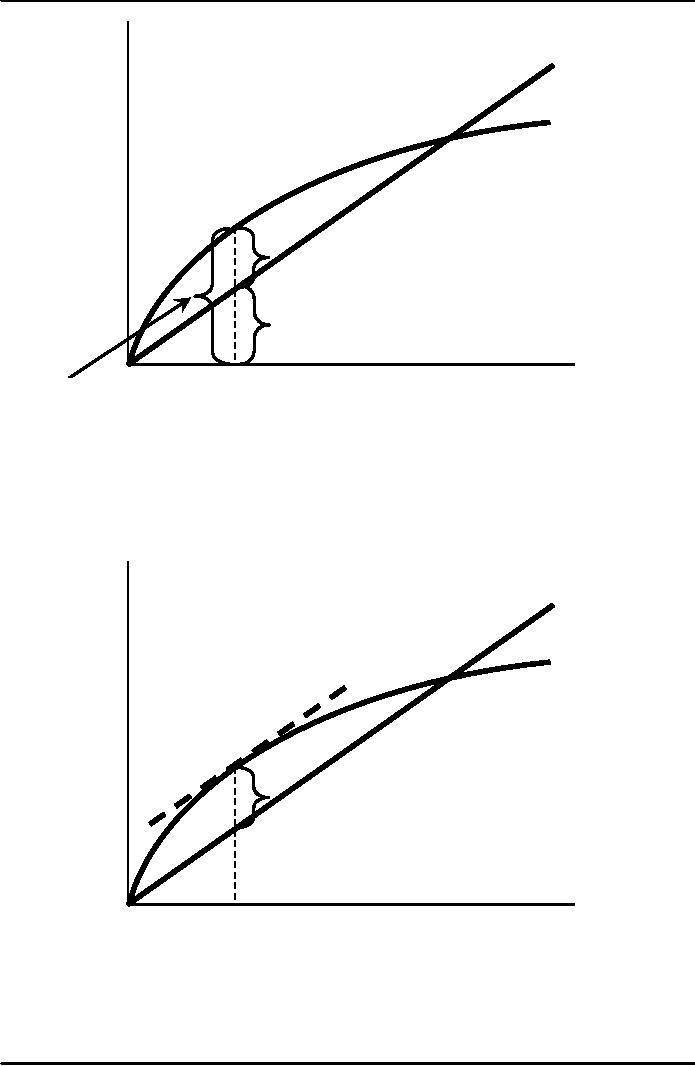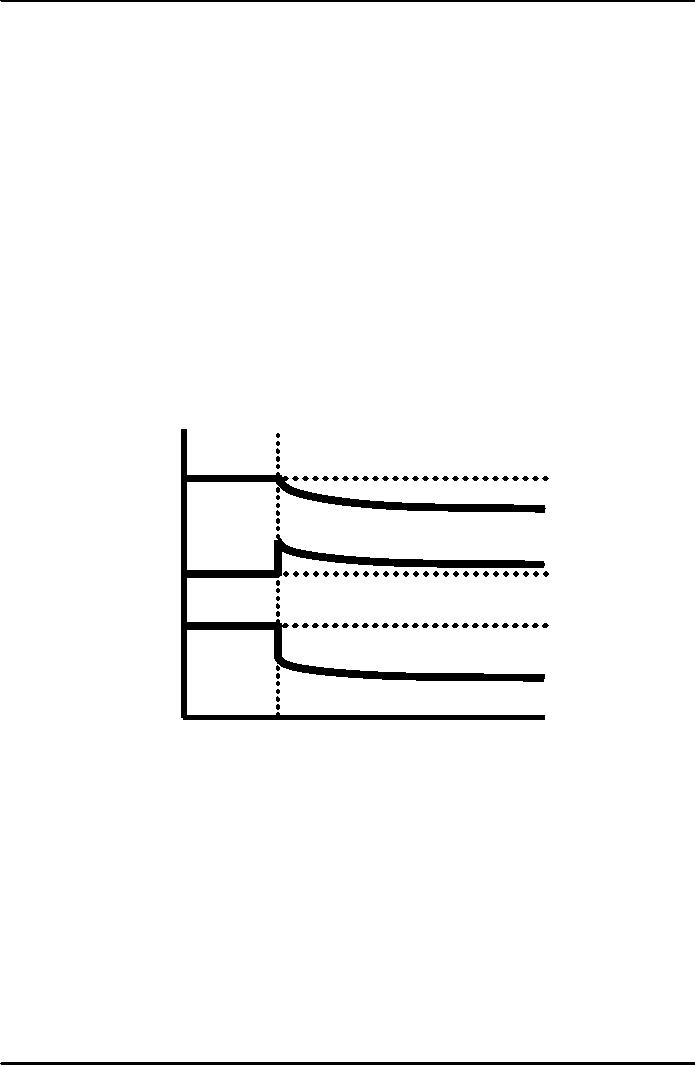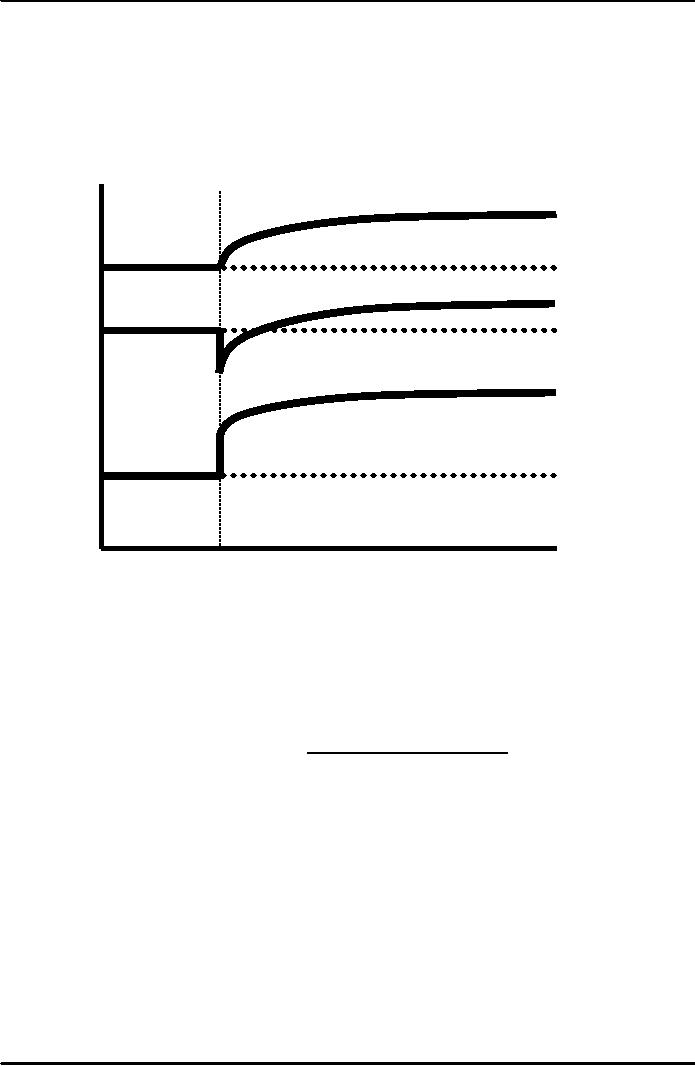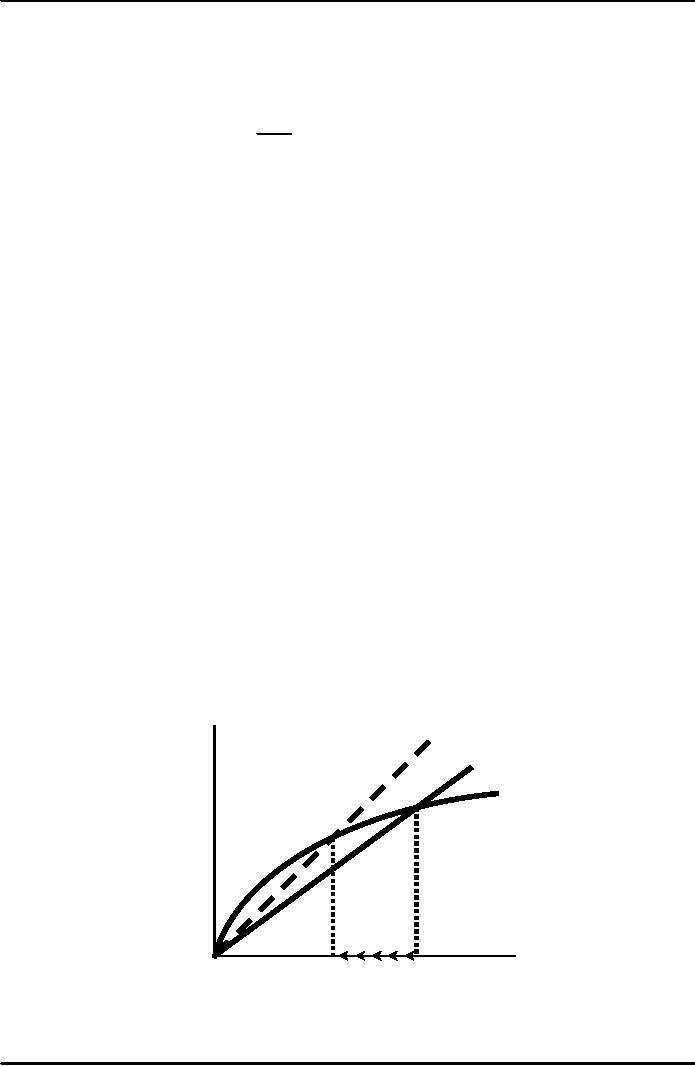 |
ECONOMIC GROWTH (Continued…):The Golden Rule Capital Stock |
| << ECONOMIC GROWTH (Continued…):The Steady State |
| ECONOMIC GROWTH (Continued…):The Golden Rule, Policies to promote growth >> |

Macroeconomics
ECO 403
VU
LESSON
21
ECONOMIC
GROWTH (Continued...)
The
Golden Rule:
introduction
�
Different
values of s lead to different
steady states.
How
do we know which is the
"best" steady state?
�
Economic
well-being depends on consumption, so
the "best" steady state
has the highest
possible
value of consumption per
person:
c* =
(1s) f(k*)
�
An
increase in s
�
leads to higher
k and y , which may raise
c
*
*
*
�
reduces
consumption's share of income
(1s),
which
may lower c*
�
So,
how do we find the s and
k* that
maximize c*?
The
Golden Rule Capital
Stock
K*gold =
the
Golden Rule level of
capital, the steady state
value of k that maximizes
consumption.
To
find it, first express c* in
terms of k*:
=
y*
-
i*
C*
-
i*
=
f (k*)
-
δk*
=
f (k*)
In
general:
i
=
Δk +
δk
In
the steady state: i*
=
δk*
because
Δk =
0.
Then,
graph f(k*) and δk*,
and look for the
point where the gap
between them is biggest.
82

Macroeconomics
ECO 403
VU
steady
state
δ
k*
output
and
depreciation
f(k*)
C*gold
i*gold =
δk*gold
k*gold
Steady-state
Y*gold
= f(k*gold)
capital
per
worker,
k*
c* =
f(k*) -
δk*is
biggest where the slope of
the production function
equals the slope of
the
depreciation
line: MPK = δ
steady
state
δ
k*
output
and
depreciation
f(k*)
*
C
gold
k*gold
Steady-state
capital
per
worker,
k*
83

Macroeconomics
ECO 403
VU
The
transition to the Golden
Rule Steady State
�
The
economy does NOT have a
tendency to move toward the
Golden Rule steady
state.
�
Achieving
the Golden Rule requires
that Policymakers adjust
s.
�
This
adjustment leads to a new
steady state with higher
consumption.
�
But
what happens to consumption
during the transition to the
Golden Rule?
Starting
with too much
capital
If
k
* >
k
gold
*
then
increasing c* requires
a fall in s.
In
the transition to the Golden
Rule, consumption is higher at
all points in time.
y
c
i
t0
Time
84

Macroeconomics
ECO 403
VU
Starting
with too little
capital
If
k
* <
k
gold
*
then
increasing c* requires
an increase in s.
Future
generations enjoy higher
consumption, but the current
one experiences an initial
drop
in
consumption.
y
c
i
Time
t0
�
The
basic Solow model cannot
explain sustained economic
growth. It simply says that
high
rates
of saving lead to high
growth temporarily, but the
economy eventually approaches
a
steady
state.
�
We
need to incorporate two
sources of growth to explain
sustained economic
growth:
population
and technological
progress.
85

Macroeconomics
ECO 403
VU
Population
Growth
�
Assume
that the population--and
labor force-- grow at rate
n. (n is exogenous)
ΔL
= n
L
EX:
Suppose L = 1000 in year 1
and the population is
growing at 2%/year (n =
0.02).
�
Then
ΔL =
n L = 0.02 �
1000 =
20,
so
L = 1020 in year 2.
Break-even
investment
(δ
+
n)k
= break-even
investment,
the
amount of investment necessary to
keep k constant.
Break-even
investment includes:
�
δ
k to
replace capital as it wears
out
�
n
k to equip new workers with
capital
(otherwise,
k would fall as the existing
capital stock would be
spread more thinly over
a
larger
population of workers)
The
equation of motion for
k
�
With
population growth, the
equation of motion for k
is
Δk
= s f(k) - (δ
+
n)
k
Where
S
f(k)= actual
investment
(δ
+
n)
k = breakeven
investment
The
impact of population
growth
(δ +n2)
k
Investment,
(δ +n1)
k
break-even
investment
sf(k)
k2*
k1*
Capital
per
worker,
k
86

Macroeconomics
ECO 403
VU
Prediction:
Higher
n
⇒
lower
k*.
�
And
since y
=
f(k)
,
�
lower
k*
⇒
lower
y*
.
Thus,
the Solow model predicts
that countries with higher
population growth rates
will
�
have
lower levels of capital and
income per worker in the
long run.
The
Golden Rule with Population
Growth
To
find the Golden Rule
capital stock, we again
express c*
in
terms of k*:
=
y*
-
i*
c*
=
f
(k*
)
-
(δ
+
n)
k*
c*
is
maximized when
MPK
= δ
+
n
or
equivalently,
MPK
-
δ =
n
In
the Golden Rule Steady
State, the marginal product
of capital net of depreciation
equals the
population
growth rate.
87
Table of Contents:
- INTRODUCTION:COURSE DESCRIPTION, TEN PRINCIPLES OF ECONOMICS
- PRINCIPLE OF MACROECONOMICS:People Face Tradeoffs
- IMPORTANCE OF MACROECONOMICS:Interest rates and rental payments
- THE DATA OF MACROECONOMICS:Rules for computing GDP
- THE DATA OF MACROECONOMICS (Continued…):Components of Expenditures
- THE DATA OF MACROECONOMICS (Continued…):How to construct the CPI
- NATIONAL INCOME: WHERE IT COMES FROM AND WHERE IT GOES
- NATIONAL INCOME: WHERE IT COMES FROM AND WHERE IT GOES (Continued…)
- NATIONAL INCOME: WHERE IT COMES FROM AND WHERE IT GOES (Continued…)
- NATIONAL INCOME: WHERE IT COMES FROM AND WHERE IT GOES (Continued…)
- MONEY AND INFLATION:The Quantity Equation, Inflation and interest rates
- MONEY AND INFLATION (Continued…):Money demand and the nominal interest rate
- MONEY AND INFLATION (Continued…):Costs of expected inflation:
- MONEY AND INFLATION (Continued…):The Classical Dichotomy
- OPEN ECONOMY:Three experiments, The nominal exchange rate
- OPEN ECONOMY (Continued…):The Determinants of the Nominal Exchange Rate
- OPEN ECONOMY (Continued…):A first model of the natural rate
- ISSUES IN UNEMPLOYMENT:Public Policy and Job Search
- ECONOMIC GROWTH:THE SOLOW MODEL, Saving and investment
- ECONOMIC GROWTH (Continued…):The Steady State
- ECONOMIC GROWTH (Continued…):The Golden Rule Capital Stock
- ECONOMIC GROWTH (Continued…):The Golden Rule, Policies to promote growth
- ECONOMIC GROWTH (Continued…):Possible problems with industrial policy
- AGGREGATE DEMAND AND AGGREGATE SUPPLY:When prices are sticky
- AGGREGATE DEMAND AND AGGREGATE SUPPLY (Continued…):
- AGGREGATE DEMAND AND AGGREGATE SUPPLY (Continued…):
- AGGREGATE DEMAND AND AGGREGATE SUPPLY (Continued…)
- AGGREGATE DEMAND AND AGGREGATE SUPPLY (Continued…)
- AGGREGATE DEMAND AND AGGREGATE SUPPLY (Continued…)
- AGGREGATE DEMAND IN THE OPEN ECONOMY:Lessons about fiscal policy
- AGGREGATE DEMAND IN THE OPEN ECONOMY(Continued…):Fixed exchange rates
- AGGREGATE DEMAND IN THE OPEN ECONOMY (Continued…):Why income might not rise
- AGGREGATE SUPPLY:The sticky-price model
- AGGREGATE SUPPLY (Continued…):Deriving the Phillips Curve from SRAS
- GOVERNMENT DEBT:Permanent Debt, Floating Debt, Unfunded Debts
- GOVERNMENT DEBT (Continued…):Starting with too little capital,
- CONSUMPTION:Secular Stagnation and Simon Kuznets
- CONSUMPTION (Continued…):Consumer Preferences, Constraints on Borrowings
- CONSUMPTION (Continued…):The Life-cycle Consumption Function
- INVESTMENT:The Rental Price of Capital, The Cost of Capital
- INVESTMENT (Continued…):The Determinants of Investment
- INVESTMENT (Continued…):Financing Constraints, Residential Investment
- INVESTMENT (Continued…):Inventories and the Real Interest Rate
- MONEY:Money Supply, Fractional Reserve Banking,
- MONEY (Continued…):Three Instruments of Money Supply, Money Demand